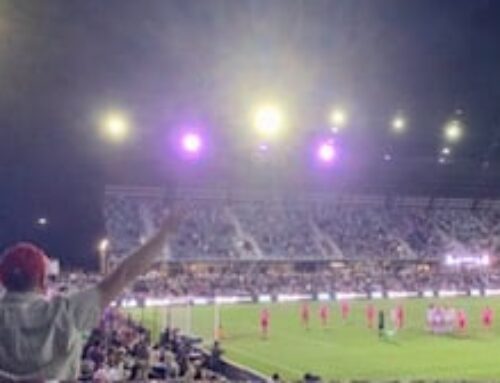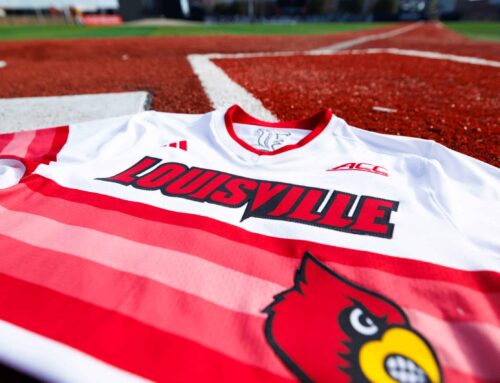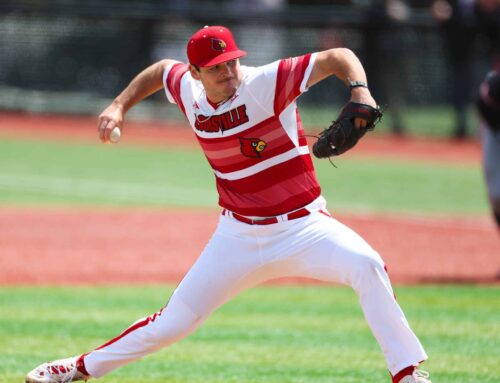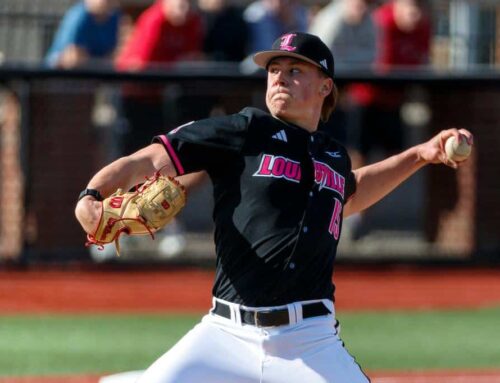By Dalton Ray
CINCINNATI BEARCATS
Mick Cronin’s teams are known for rebounding on the offensive glass, long athletic
defenders, and low percentage jump shooters. This year’s team should fit the same mold and
will be led by senior guard Sean Kilpatrick. Last year’s team went 22-12, 9-9 in conference
but had a very disappointing postseason. After beating Providence in the first round of
the Big East Tournament they lost to Georgetown by 19 in the quarterfinals and then
followed that up with a four-point loss against Creighton in the second round of the NCAA
Tournament.
Even though four projected starters for the 2013 team are upperclassmen only two,
Kilpatrick and senior forward Titus Rubles, averaged more than 20 minutes per game. Once
again the Bearcats shouldn’t have a problem with defending or rebounding as they return
their top three leading rebounders in Kilpatrick, Rubles, and fellow senior projected starter
Justin Jackson. In addition Cronin added the athletic four-star power forward Jermaine
Lawrence, 6-foot-9, 200 pounds, to compliment their length and rebounding.
Like previous teams, this one has most of its questions coming on the offensive end.
Kilpatrick averaged more points per game with 17 than the rest of the projected 2013 starter
lineup combined at 15. The offense will need contributions from starting junior guard
Ge’Lawn Guyn, talented and now-healthy sophomore Jeremiah Davis III, and newcomers
Kevin Johnson and Troy Caupain.
Cincinnati will come into the year in the top 45 and will have games on their schedule
that could bump them to a top 25 team. North Carolina State, Pittsburgh, Xavier and
number-23 New Mexico headline the non-conference schedule for the Bearcats. They will
have their hands full when it comes to conference play as the newly-formed American
Athletic Conference provides one of the deeper conferences in the nation. No. 3 Louisville,
No. 13 Memphis, No.18 UConn and Cincinnati are the heavy hitters in this conference.
The returning talent from Temple, SMU, South Florida, Houston, and Central Florida
could provide a very strong first year for the AAC.
CONNECTICUT HUSKIES
Kevin Ollie is in his second year as the head coach of the UConn Huskies and after
posting a record of 20-10 overall and 10-8 in conference play the Huskies are now done
with their postseason ban. The team returns all five starters and offers one of the best
starting guard combinations in the nation with Ryan Boatright and Shabazz Napier.
Napizer, 17.1 points per game, 4.6 assists per game, and Boatright with 15.4 points per
game and 4.4 assists per game, were both selected to the AAC All Conference Team. Napier
was one of three unanimous selections.
The outcome of the 2013-2014 season will mostly rely on the senior Napier and junior
Boatright but just how good the team can become will depend on the development of junior
forward DeAndre Daniels, sophomore Omar Calhoun, and junior Tyler Olander. The guard
play will be there but how Daniels, who averaged 21 points, nine rebounds, and three
blocked shots over his last four games, and the streaky shooter Calhoun can contribute will
be a large factor in UConn’s success. The Huskies will have size on the front court with
Daniels 6-foot-9, Olander 6-foot-10, Phillip Nolan 6-foot-10, Kentan Facey 6-foot-9 and
freshmen Amida Brimah who is 7 feet tall, that will pass anyone’s eye test. If the front court,
mainly the center position, can get boards and play solid defense then this team could be
very dangerous heading into March.
Calhoun and Daniels both averaged double digits last season but the next two leading
scorers that return are Olander with 4.2 and Nolan with 1.7. The front court must
contribute in order for this UConn team to live up to full potential. Starting off the season
ranked number 18 in the nation, the Huskies will face their toughest non-conference games
against Maryland, No. 10 Florida, Washington, and Boston College.
HOUSTON COUGARS
Coming from Conference USA, the Houston Cougars finished out last year with a 20-
13 record and a 7-9 in conference mark. The Cougars fell in the quarterfinals to UTEP in
the conference tournament and then they were invited to play in the College Basketball
Invitational in which again they were defeated in the quarterfinals by George Mason. Three
starters return from this 20-win basketball team.
With the returning wing duo of TaShawn Thomas and Danuel House, Houston has
the play makers in place to make a stamp on their first year in the AAC. Head coach James
Dickey has improved his win total over the past two years but continuing this streak might
be a difficult task. The jump from the C-USA to AAC could be a rough transition for the
Cougars as ranked 269 in nation last year in defensive efficiency and allowed opponents
to shoot 49% from two-point range. With conference opponents such as Russ Smith, Joe
Jackson, Shabazz Napier, Isaiah Sykes and Anthony Collins, it can be a long season for the
Cougars if their defensive intensity doesn’t step up. If Houston can play quality defense then
they can be a competitor, but if not the Cougars will have their first year in the AAC as
one they can forget about. They won ten games last year by five points or less, with stiffer
competition those close wins could easily turn into losses.
Houston might have one of the better frontcourts in the AAC with Thomas, Freshman
of the Year in C-USA House, returning senior starter J.J. Richardson and 6-foot-10 transfer
Danrad Knowles. While the front court seems to be set the back court isn’t as clear. Joseph
Young, the starting point guard for the 2012 team, transferred to Oregon. With the loss of
Young, Tione Womack will take over the point but averaged only 2.7 points in the 2012
year. Jherrod Stiggers hit 67 threes last season but really hasn’t proved anything else. The
Baylor transfer L.J. Rose should provide points off the bench as he was a top-75 recruit
before coming out. If Rose, Knowles, and Stiggers step up their performance then Houston
could easily become an underrated team in the AAC.
SOUTH FLORIDA BULLS
The 2012-13 year was one to forget in south Florida. The school had 58.8
points per game (331st), 32.6 rebounds per game (256th), 11.3 assists per game
(278th), and a .389 shooting percentage led to a 12-19 record and a 3-15 Big
East record. Last season’s team had a large problem with rebounding due to
their lack of a true center and interior depth. Head coach Stan Heath looks to
patch this up as he added center John Egbunu 6-foot-10, 230 pounds, forwards
Chris Perry 6-foot-8, 245 pounds and Dre’Kalo Clayton 6-foot-6, 275 pounds, as
well as returning last season’s leading rebounder.
Egbunu and Perry were both four-star recruits and will look to help out
sophomore forward Zach LeDay in the paint. Egbunu will provide the inside
presence they will need to get attention away from outside players and Perry’s
7-foot-5 wingspan will help the Bulls’ rebounding woes. With the arrival of some
young talent, senior Victor Rudd 6-foot-9, 235 pounds, will now have some of
the defensive pressure off of him and should be able to take advantage. Rudd
is easily the team’s go-to guy as he led the team in points at 12.3, rebounds at
6.9 and was second in minutes at 34 . Anthony Collins will be the starting point
guard, who led USF to the tournament in 2011, led the team with 36 minutes per
game and 6.5 assists last season.
JaVontae Hawkins and junior college transfer Corey Allen will be guys who knock
down open shots as a result of new post play. Freshman Bo Ziegler 6-foot-6,
180 pounds, will also get some time giving Heath a deeper bench, something
he didn’t have a year ago. The Bulls will be bigger and better but they’re still
rebuilding. Unless the bigs make a huge improvement on the boards and the
team increases their defensive pressure then this won’t be a NCAA tournament
team.
UCF KNIGHTS
Central Florida might not come out and win every game in the AAC but they will more
than likely cause some match-up problems. This UCF team is not the average college
basketball team. The primary ball handler is the small forward and the center led C-USA in
three-point shooting last season.
Isaiah Sykes is the Knights’ do-it-all player and led the team in points at 16, assists at 4.5 and
steals at 2.3. He was second in rebounds at 7.5. He was also selected to the AAC preseason
All-Conference Team.
If Kasey Wilson continues to improve then Sykes and the rest of the Knights could have a
successful first season in the AAC. The 6-foot-7 forward hit 42 of his 84 attempts last season
and forced opponents to pull their big men out of the paint, but his 4.4 rebounds a game
must increase. The Knights as a team need to focus more on rebounding, last season their
66.9 defensive rebound percentage ranked them 229th in the country, and that was with the
school’s all-time leading rebounder in the lineup. UCF has some serious issues defensively
inside, allowing foes to shoot 49.4 percent from 2-point range. Eugene McCrory, a 6-8
junior college All-American last season, will be looked to make a difference, and the two
sophomores Staphon Blair and Dylan Karell should contribute.
Tristan Spurlock excels more when he’s not banging away inside at the center position
but the 6’8, 230lbs senior can do it if need be. Senior Calvin Newell should also add some
consistent scoring as he averaged 11 points per game last season. Returning five of the top
seven players off last year’s 20-win team and adding new young talent the Knights will be
experienced and competitive in the AAC.
MEMPHIS TIGERS
Memphis had a 2012-13 record of 31-5 with a perfect 16-0 record in conference play and
has his team headed into the 2013-14 season as the number 13 overall ranked team. Josh
Pastner has followed in John Calipari’s footsteps in Memphis, in a way. Pastner always finds
a way to land big-name recruits, between his 2012 and 2013 classes’ he has hauled in a total
of six four-stars and one five-star in Austin Nichols. Now add this to the guard play of Joe
Jackson and Geron Johnson and Chris Crawford on the wing and this Memphis team can
run with most teams in the country. The biggest problem for Memphis in recent years is all
of Pastner’s talent that has came through has not always lived up to the full potential due to
inexperience and not having a quality team around the players.
Memphis has a chance to break this routine as they have a combination of experienced
veteran players and as usual talented young players. Forward Shaq Goodwin (6’9, 245lbs)
showed many signs of the type of player he could be in just his freshman year. Finishing the
year with 7.7 PPG and 4.4 RPG he needs to be more consistent in order for the Tigers to
move on to the next level. Another factor standing in Memphis’ way of success this year will
once again be how they fare with turnovers. Last season’s 20.8 turnover percentage, which
ranked 225th in the country, cost them games they could have won. Pastner’s high tempo
offense is one reason for the turnovers but he hopes his upper-class filled back court will
cut down on this state drastically. Senior transfer Michael Dixon Jr. and freshmen Kuran
Iverson, Nick King, Rashawn Powell, and Dominic Woodson will all look to contribute
immediately.
Memphis’ defense hopes to be as good as it’s been in recent years. Last season they
ranked 24th in the nation in defensive efficiency and 18th in steal percentage with 12.7%.
With two match-ups against top ten teams in #8 Oklahoma State and #10 Florida plus the
move to the AAC the Tigers won’t have as soft as a schedule as they had when they were
in the C-USA. The stiffer competition could cause problems for Pastner’s team but he has
the talent to match up with most teams in the country. Another 30-win season might not
be in the horizon for the Tigers but all the makings are there for competing for an AAC
championship and an appearance in the NCAA Tournament.
RUTGERS SCARLET KNIGHTS
Last year Rutgers went 16-16 with a Big East record of 6-14. Not many universities
have had as rough as a 2013 year as Rutgers. Between the videos of former head Mike Rice
throwing balls at his players, multiple transfers that followed his departure and new AD
Julie Hermann’s controversial past the Scarlet Knights needed a head coach that could lead
this team out of the darkness. They reached into the NBA to find a coaching candidate and
selected Eddie Jordan to take charge of this team.
Jordan’s team lost five players off last year’s team and he will ask many fresh faces off
the bench to put in a large work load. Four juniors and a senior will make up a line up that
shouldn’t make too many rookie mistakes led by junior guard Myles Mack. Mack, a very
underrated guard, led the Big East in 3-point shooting percentage last season, led the team
in minutes per game, was second in scoring with 13.6 wile shooting 48% from the floor. The
rest of the line up didn’t average more than seven points but they do return their top two
rebounders in Wally Judge and Kadeem Jack. Guard Jerome Seagears will be looked at to
step up on the offensive end to help Mack as Malick Kone’s presence is felt in the defensive
side of the court.
Rutgers has been given a big lift within the past couple of weeks as the NCAA ruled
that transfers Kerwin Okoro from Iowa State and J.J. Moore from Pittsburgh will both be
immediately eligible. Both should challenge for major playing time and starting roles and
along with junior college transfers DVon Campbell and Craig Brown should give Rutgers
more firepower. Defensive struggles will need to be addressed; otherwise this season won’t
be very pretty for the Knights.
SMU MUSTANGS
There’s a very interesting situation in Dallas, Larry Brown’s team will return all five
starters off last year’s team that went 15-17 overall with a 5-11 in conference record, but
there is a chance none of them might start. Each of his starters last season averaged at
least 32 minutes per game but with five new comers to the team there will be competition
for starting roles. With new competition, talent, and a Hall of Fame coach in Brown the
Mustangs can really turn some heads this year.
Last year’s starting guards Nick Russell (14 PPG) and Ryan Manuel (12.1 PPG) were two
of the team’s leading scorers, now both will be pushed for playing time by four new arrivals.
Illinois State transfer Nic Moore is expected to take over the point guard spot as he averaged
10 points and 3 assists last season as a freshman. McDonalds All-American Keith Frazier
(6’5, 190) has good range, great athleticism, and will almost start immediately. Transfers
Crandell Head and Sterling Brown will also fight for back court minutes. The front court is
just as crowded. The two returning starting forwards and center are joined by No. 1 JuCo
recruit Yanick Moreira (6’11, 220lbs) and Villanova transfer Markus Kennedy (6’9, 245lbs).
Jalen Jones, Shawn Willaims, and Cannen Cunningham started for the Mustangs last season
and combined had an average of 31 points, 19 rebounds, 3 blocks, and 3 steals per game.
With Russell and Jones being the only starters off last year’s team expected to start despite
returning everyone SMU should be one of the deeper teams in the AAC. Since Brown has
been at SMU the talent level has increased and at this point Brown has the pieces in place,
all he has to do is fit everything together. The Mustangs will travel to No. 24 Virginia in late
November and that could prove to be their toughest non-conference opponent.
TEMPLE OWLS
In recent years the Temple Owls have been one of the more consistent teams in the
nation, they’ve won 20 games six years in a row now, last year posting a 24-10 overall
record and an 11-5 in conference record. But like most new teams to this conference the
increased overall competition might put a halt to that. Better competition, small amount of
experience, and lack of proven scorers could cause Temple a hiccup in the six consecutive
seasons with 20 wins or more. After losing Khalif Wyatt, Scootie Randall and Rahlir Hollis-
Jefferson the Owls may not be able to bounce back.
Without a double-figure scorer on a team that already has to address some significant
defensive issues this could be a long season for the Owls. Temple’s D allowed 49 percent
effective field goal shooting, and conference opponents hit 38.6 percent of their 3-pointers.
Plus not to make anything better they lost five of their top seven key players from last year’s
squad. Not only will they need to focus on scoring by committee and team defense but they
will be doing this with unproven, inexperienced players. Anthony Lee (6’9, 230lbs) and Will
Cummings (6’2, 175lbs) return for their junior seasons and the guard and center combo will
need to adjust their game to the changed, slower offense. Lee averaged 9.8 points per game
and 6.8 rebounds per game last season. Lee and Cummings will both be more involved on
the offensive side this season.
Senior Dalton Pepper will be leaned on for his defensive impact and sophomore guard
Quenton Decosey is the team’s scorer. The backcourt is thin but coach Fran Dunphy’s team
will rely on freshman Josh Brown to play some minutes if needed. The front court is a little
on the small side. Outside of Lee (6’9) and Devontae Watson (6’10) the Owls have one
person 6’8 or taller in freshman Mark Williams. Temple will more than likely come in the
year a small-ball, team-ball type approach. If sophomore and starting forward Daniel Dingle
(6’7, 225lbs), Brown, and Williams all step up this could be a 20-win team






